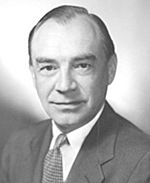Albert Coons facts for kids
Quick facts for kids
Albert Hewett Coons
|
|
|---|---|
 |
|
| Born | June 28, 1912 Gloversville, New York, U.S.
|
| Died | September 30, 1978 (aged 66) |
| Alma mater | Williams College (BS) Harvard Medical School (M.D.) |
| Awards | Lasker Award (1959) Paul Ehrlich and Ludwig Darmstaedter Prize (1961) Gairdner Foundation International Award (1962) |
| Scientific career | |
| Fields | Physician, internist, educator, author, immunologist, pathologist |
| Institutions | Harvard University |
| Influences | Hans Zinsser |
Albert Hewett Coons (born June 28, 1912 – died September 30, 1978) was an American doctor. He was a pathologist, who studies diseases, and an immunologist, who studies the body's immune system. Dr. Coons was the first person to think of and create a special way to "label" antibodies. Antibodies are tiny defenders in our bodies. He used a glowing light to make them visible in the early 1940s. This method is called immunofluorescence.
Contents
Early Life and Education
Albert Coons was born in Gloversville, New York, on June 28, 1912. His father owned a company that made gloves. His grandfather, Eugene Coons, was also a doctor.
Albert went to public schools in Gloversville. He earned a Bachelor of Science degree from Williams College in Williamstown, Massachusetts, in 1933. Then, he received his medical degree (M.D.) from Harvard Medical School in 1937.
After medical school, Albert Coons trained to become an internal medicine doctor. He worked at Massachusetts General Hospital in Boston, Massachusetts. During his training, he joined a special lab. There, he studied bacteriology (the study of bacteria) and immunology. He was greatly influenced by Hans Zinsser, a leading immunologist and microbiologist.
A Big Idea in Berlin
In 1939, Dr. Coons took a trip to Berlin, Germany. While there, he had a very important scientific idea. He was thinking about a condition called rheumatic fever. He wondered how the body's immune system was involved in this disease.
He realized that no one had ever found the specific parts of the immune system, called antigens and antibodies, in the affected areas of the body. He thought it would be easier to find the antigen. He later wrote: "The idea of labeling an antibody molecule with a visible label was perfectly obvious." This meant making antibodies glow so they could be seen.
When he shared his idea with German scientists, they were doubtful. At that time, scientists didn't know much about antibodies. There was no way to attach a glowing molecule to them. Also, the glowing chemicals themselves were very new. But Dr. Coons was not discouraged. He returned to Boston, ready to work on his project.
Military Service During World War II
In 1942, Dr. Coons's research was paused. He was called to serve in the Medical Corps of the United States Army during World War II. He traveled to the southwest Pacific Theater. This area included places like New Guinea, the Solomon Islands, and the Philippines.
He was the chief laboratory officer for the 105th General U.S. Army Hospital. Dr. Coons left the Army at the end of 1945. He had reached the rank of Major (O4). He received two awards for his service: the Asiatic-Pacific Campaign Medal and the World War II Victory Medal.
Career at Harvard Medical School
After the war, Dr. Coons went back to Boston. He continued his work on immunohistochemistry. This is the study of chemicals in tissues using immune reactions. He worked with Louis Fieser, an organic chemist, and his team.
Before the war, they had successfully attached a glowing chemical, called anthracene isocyanate, to antibodies that fought pneumonia bacteria. This special product still worked. It could clump together the pneumonia bacteria. Also, the bacteria glowed brightly. This made them easy to see under a microscope with ultraviolet light.
Impact of His Discoveries
This basic method became very important. It was used for many different antigens and antibodies. It led to new ways of diagnosing diseases using glowing microscopes. These methods are now used all over the world in medicine and cell biology.
Many scientists came to Dr. Coons's lab at Harvard. They helped to improve his technique. They used it with electron microscopes and light microscopes. Dr. Coons advanced through the ranks at Harvard Medical School. In 1953, he became a Career Investigator for the American Heart Association.
He also did more work on how antibodies are made inside and outside the body. He studied something called immunological "tolerance." This is when the body's immune system learns not to attack its own cells.
Awards and Recognition
In 1959, Dr. Coons received the famous Albert Lasker Award in Basic Research. This award recognized his amazing achievements. In 1962, he became a member of the National Academy of Sciences.
In 1970, Harvard University gave him a special named professorship. He worked in the Department of Bacteriology and Immunology, and later in the Department of Pathology. He was also president of the American Association of Immunologists from 1960 to 1961. He received several other awards and honorary degrees from universities around the world. These included the Paul Ehrlich Award in 1961 and the Gairdner Foundation Annual Award in 1963.
Even with all these honors, Dr. Coons remained a humble and quiet person. He was dedicated to his work, his family, his friends, and his students.
Personal Life
Dr. Coons passed away in September 1978 in Brookline, Massachusetts, due to health issues. He is buried in Cambridge, Massachusetts. He was survived by his wife, Phyllis, who was a writer for the Boston Globe newspaper. He also had a son, Albert H., Jr., and four daughters: Elizabeth, Susan, Hilary, and Wendy.
See also
 In Spanish: Albert Coons para niños
In Spanish: Albert Coons para niños

